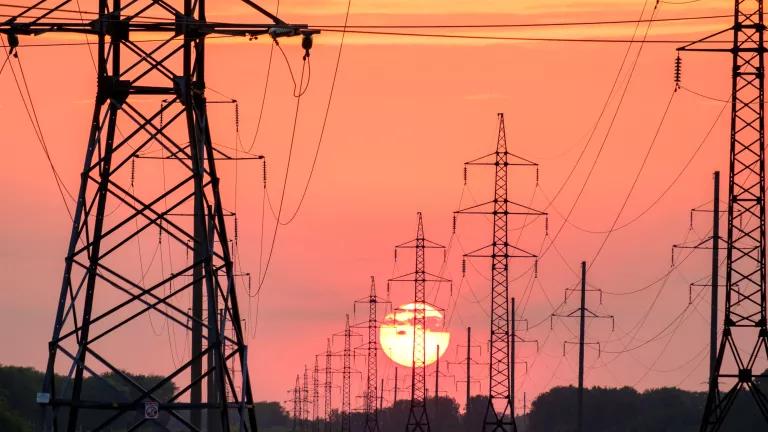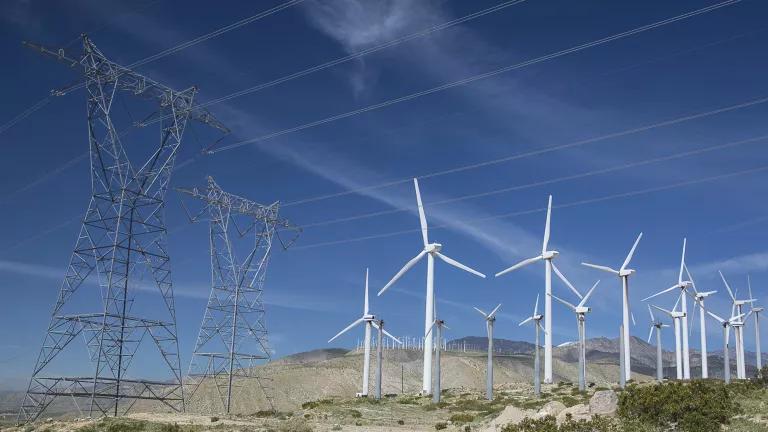Getting Smart About Transmission Lines: A Southwest Story
Ten West Link demonstrates how we can build infrastructure in a way that is Smart from the Start, a methodology that enables us to build the renewable energy projects we need while protecting wild spaces.

Earlier this year, officials traveled to an area west of Phoenix to help break ground on a transmission project that will carry renewable energy to consumers in California and the Southwest.
Ten West Link, a 125-mile transmission line, was among the first transmission projects guided through the permitting process by the Federal Permitting Improvement Steering Council, which served as the single point of contact for more than two dozen federal and state agencies. With our nation on the verge of a renewable energy revolution, we need to accelerate construction of new transmission lines to carry power from remote wind and solar projects to cities and towns. Ten West Link demonstrates how we can get this crucial infrastructure built in a way that is Smart from the Start, a methodology that enables us to build the renewable energy projects we need while protecting our most valuable wild spaces and the wildlife that calls these spaces home.
The original proposed route for Ten West Link was not smart. It had a number of problems, including crossing the Kofa National Wildlife Refuge, which encompasses more than 500,000 acres between the Kofa Mountains and the Castle Dome Mountains in Arizona. The refuge is a crucial habitat for many important species including the endangered Sonoran pronghorn as well as desert bighorn sheep and mountain lions.
After the project changed hands, a new developer decided to shift the route to avoid this ecologically sensitive area. As a result of this shift, the project gained support from environmental organizations for its modified route, and now is moving ahead with construction.
Why We Need More Transmission
Building more transmission has several important benefits. First and foremost, we need more transmission to carry increasingly cheap renewable energy to customers, which will reduce greenhouse gas emissions and lower costs for customers. In addition, transmission improves the reliability of the grid by ensuring that we can get power to where it is most needed. This is a key concern in places like California, Texas and New England that have struggled to keep the lights on in the face of recent extreme weather events. Yet the transmission planning process has failed to keep up with a surge of wind and solar projects. And with the historic clean energy investments from last year’s Inflation Reduction Act, more renewable resources are going to be added to already overburdened interconnection queues in many parts of the country.
The good news is that we are seeing a lot of momentum on transmission, with the Federal Energy Regulatory Commission overhauling its transmission planning rules and Congress providing the Department of Energy (DOE) with new loan, grant, and other financing authorities to help build more transmission. DOE is using this new authority to speed up construction of high-capacity transmission lines with priority given to projects that improve grid resilience and reliability, facilitate the transfer of electricity between different regions of the country, and lower greenhouse gas emissions.
But while this momentum is growing, there is also a call to gut our most basic environmental laws and safeguards with the supposed aim of getting new transmission lines built quickly. This is not a tradeoff we should be willing to make, nor do we have to. NRDC has joined with other groups to outline ways to build transmission quickly without compromising these bedrock environmental or social justice safeguards.
Why Ten West Link is a Success Story
To fully appreciate the significance of Ten West Link, let’s wind the clock back to the not-too-distant past when large transmission projects were routed via the shortest distance from Point A to Point B with little thought to avoiding conflicts with natural, cultural, or other public resources. This began to change thanks to pioneering work by environmental advocates that took part in planning forums across the West.
Separately, the Bureau of Land Management (BLM) sought to designate low-conflict routes known as the West-wide Energy Corridors that were appropriate for the development of transmission lines on BLM-managed land. At first, these proposed corridors fell short in several important ways. For example, the first iteration of the corridors only analyzed connecting fossil fuel resources to the grid and omitted renewables. The routes also failed to avoid high conflict areas such as environmentally sensitive habitat and high-quality lands with wilderness characteristics. These omissions led environmental organizations, including NRDC, to challenge the initial designations.
In 2018, as issues with the original corridors were being addressed, BLM released a draft environmental review for Ten West Link with the preferred route running through a West-wide Energy Corridor along Interstate 10 in Arizona and California rather than the original plan to cut through the Kofa National Wildlife Refuge, an alternative that avoided the unacceptably high impacts of running the line through the wildlife refuge.
Because Ten West Link has yet to be completed, some may say this demonstrates the need to speed the process up by bypassing our fundamental environmental laws and protections. However, Ten West Link should be viewed as a success story because it shows what can be accomplished when we do things the right way. By working with local communities and regulators to find designated, lower conflict pathways, success can come quicker and with fewer impacts on the ground. Rather than being a cautionary tale, Ten West Link demonstrates the importance of early identification of appropriate areas so we can guide our clean energy future in the right way. Sounds pretty smart, doesn’t it?



